
Alfred Gerald Caplin, better known as Al Capp, was an American cartoonist and humorist best known for the satirical comic strip Li'l Abner, which he created in 1934 and continued writing and drawing until 1977. He also wrote the comic strips Abbie an' Slats and Long Sam (1954). He won the National Cartoonists Society's Reuben Award in 1947 for Cartoonist of the Year, and their 1979 Elzie Segar Award, posthumously for his "unique and outstanding contribution to the profession of cartooning".

The National Cartoonists Society (NCS) is an organization of professional cartoonists in the United States. It presents the National Cartoonists Society Awards. The Society was born in 1946 when groups of cartoonists got together to entertain the troops. They enjoyed each other's company and decided to meet on a regular basis.

Charles Monroe "Sparky" Schulz was an American cartoonist, the creator of the comic strip Peanuts which features his two best-known characters, Charlie Brown and Snoopy. He is widely regarded as one of the most influential cartoonists in history, and cited by many cartoonists as a major influence, including Jim Davis, Murray Ball, Bill Watterson, Matt Groening, and Dav Pilkey.

Peanuts is a syndicated daily and Sunday American comic strip written and illustrated by Charles M. Schulz. The strip's original run extended from 1950 to 2000, continuing in reruns afterward. Peanuts is among the most popular and influential in the history of comic strips, with 17,897 strips published in all, making it "arguably the longest story ever told by one human being". At the time of Schulz's death in 2000, Peanuts ran in over 2,600 newspapers, with a readership of roughly 355 million across 75 countries, and had been translated into 21 languages. It helped to cement the four-panel gag strip as the standard in the United States, and together with its merchandise earned Schulz more than $1 billion. It got a movie adaptation in 2015 by Blue Sky Studios.
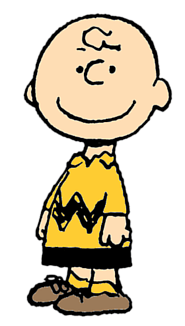
Charles "Charlie" Brown is the principal character of the comic strip Peanuts, syndicated in daily and Sunday newspapers in numerous countries all over the world. Depicted as a "lovable loser", Charlie Brown is one of the great American archetypes and a popular and widely recognized cartoon character. Charlie Brown is characterized as a person who frequently suffers, and as a result, is usually nervous and lacks self-confidence. He shows both pessimistic and optimistic attitudes: on some days, he is apprehensive to even get out of bed because he is unable to face the world, but on others, he hopes for the best and is determined to accomplish things. Charlie Brown is easily recognized by his round head and trademark zigzag patterned shirt. His catchphrase is "Good Grief!"

It's the Great Pumpkin, Charlie Brown is a 1966 American animated Halloween television special based on the comic strip Peanuts by Charles M. Schulz. The third Peanuts special, and the second holiday-themed special, to be created, it was written by Schulz along with director/animator Bill Melendez and producer Lee Mendelson. The cast included Peter Robbins as Charlie Brown, Christopher Shea as Linus Van Pelt, Sally Dryer as Lucy Van Pelt, and Melendez as Snoopy. The special features music composed by jazz pianist Vince Guaraldi, whose contributions include the theme song "Linus and Lucy". It aired on broadcast television every year from its debut in 1966 until 2020 when it became an Apple TV+ exclusive.

Rerun Van Pelt is Linus and Lucy's younger brother in Charles M. Schulz's comic strip Peanuts. Lucy Van Pelt, his sister, disparagingly calls the situation a "rerun" of the birth of her brother Linus, so Linus nicknames the child "Rerun". Despite Lucy's disappointment, she becomes a warm and protective older sister.

Lucille "Lucy" Van Pelt is a fictional character in the syndicated comic strip Peanuts, written and drawn by Charles Schulz. She is the older sister of Linus and Rerun. Lucy is characterized as a "fussbudget", crabby, bossy and opinionated girl who bullies most other characters in the strip, particularly Linus and Charlie Brown.

Shermy is a fictional character from the comic strip Peanuts, by Charles Schulz. Schulz named him after a friend from high school. When Peanuts made its debut on October 2, 1950, Shermy sat on the curb with another early character, Patty, and spoke the first lines of dialogue, ending with "Good ol' Charlie Brown ... How I hate him!" which is ironic, considering how he became one of Charlie Brown's closest friends, along with Linus van Pelt and Schroeder.
See also: 1920s in comics, other events of the 1930s, 1940s in comics and the list of years in comics
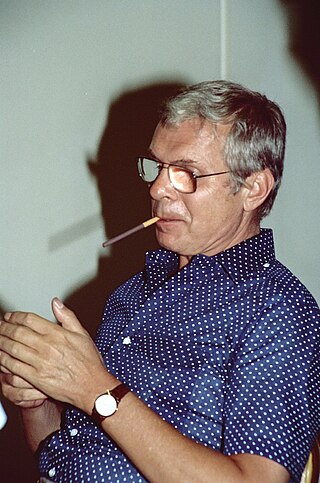
Leonard Starr was an American cartoonist, comic book artist, and advertising artist, best known for creating the newspaper comic strip On Stage and reviving Little Orphan Annie.
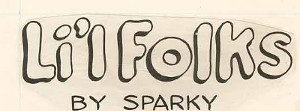
Li'l Folks, the first comic strip by Peanuts creator Charles M. Schulz, was a weekly panel that appeared mainly in Schulz's hometown paper, the St. Paul Pioneer Press, from June 22, 1947, to January 22, 1950. As Schulz's first regular cartoon, Li'l Folks can be regarded as an embryonic version of Peanuts, centered around children saying things beyond their years. Unlike Peanuts, Li'l Folks did not feature any recurring characters, though several themes were carried over to the later strip, including: Beethoven's music ; dogs resembling Snoopy that appeared in most strips; and the name Charlie Brown.

Morris S. Weiss was an American comic book and comic strip artist and writer. Active from the 1930s through the mid-1970s, he created the teen-comedy character Margie for Timely Comics, the 1940s predecessor of Marvel Comics, and was the final cartoonist on the comic strip Mickey Finn. He also worked as a writer or illustrator on numerous other strips, including Joe Palooka.
Broom-Hilda is an American newspaper comic strip created by cartoonist Russell Myers. Distributed by Tribune Content Agency, it depicts the misadventures of a man-crazy, cigar-smoking, beer-guzzling, 1,500-year-old witch and her motley crew of friends.

Leland Maurice Mendelson was an American animation producer and executive producer of many Peanuts animated specials.
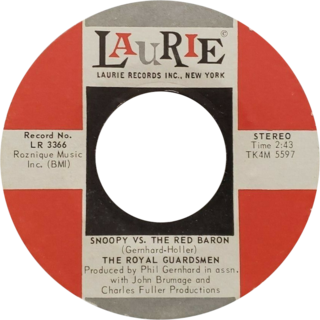
"Snoopy vs. the Red Baron" is a novelty song written by Phil Gernhard and Dick Holler and recorded in 1966 by the Florida-based pop group The Royal Guardsmen. The song was recorded at the Charles Fuller Productions studio in Tampa, Florida, and was released as a single on Laurie Records. Debuting at #122 on the Bubbling Under the Hot 100 on December 10, 1966, the single skyrocketed to #30 on December 17, 1966, shot up again to #7 on December 24, 1966 and peaked at #2 on the Hot 100 during the week of December 31, 1966 ; made #6 on the Record Retailer (UK) chart in February 1967; was #1 in Australia for 5 weeks from February 1967; and #1 for 3 weeks in Canada. On the Hot 100, "Believer" at #1 kept "Snoopy" at #2 from reaching the Hot 100 summit from December 31, 1966, through January 21, 1967, after which "Snoopy" fell off while "Believer" stayed at the top for another 3 weeks; however the song spent one week at the top of the Record World charts. The song sold close to three million copies.
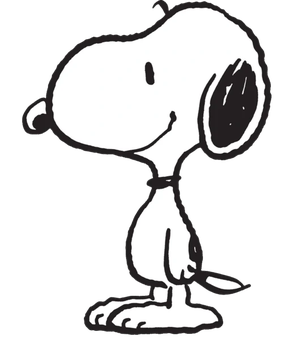
Snoopy is an anthropomorphic beagle in the comic strip Peanuts by Charles M. Schulz. He can also be found in all of the Peanuts films and television specials. Since his debut on October 4, 1950, Snoopy has become one of the most recognizable and iconic characters in the comic strip and is considered more famous than Charlie Brown in some countries. The original drawings of Snoopy were inspired by Spike, one of Schulz's childhood dogs.
Notable events of 1933 in comics.
Notable events of 1934 in comics.














